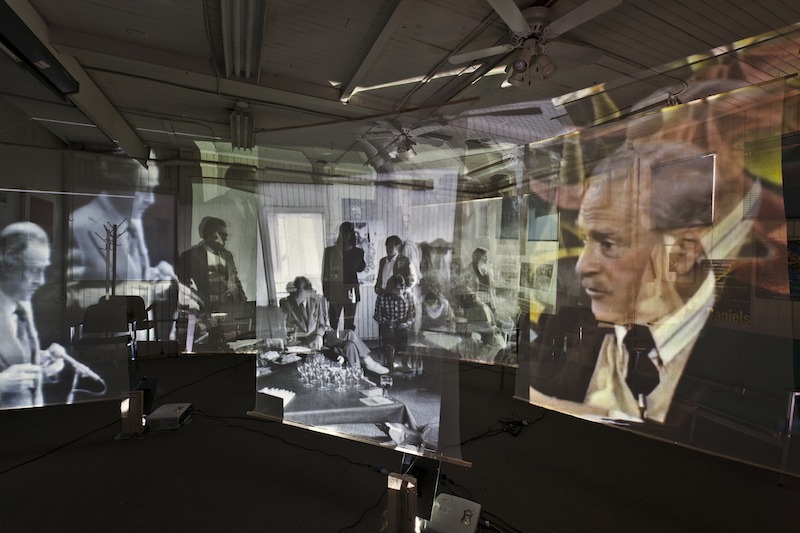
a view of Through the Vanishing Point (video documentation available below)

From 1963 until his death in 1980, Marshall McLuhan conducted his groundbreaking research at the McLuhan Program in Culture and Technology,which is commonly known as the Coach House. I greatly regret that I never attended one of McLuhan's seminars. By undertaking this work I am, in a sense, reclaiming a missed opportunity.
Within the actual space of the seminar room in the Coach House, my work conjures up something of the feel of these seminars (as I imagine them). McLuhan wrote a considerable body of commentary on the visual representation of space and I felt it appropriate to reflect these ideas of his in my visual representation of his space. In Through the Vanishing Point he wrote that the coherent, connected sense of visual space that came to the fore in the Renaissance diminished the roles of the other senses, artificially reinforced the value of a single point-of-view, and promoted detachment and disengagement. In contrast, McLuhan championed what he called a ̉mosaicÓ approach open to multiple perspectives in space and time, which is, for example, more characteristic of pre-Renaissance pictorial representation. When we strive for the visual coherence of a unified spatial perspective presenting a single moment in time, McLuhan felt that we sacrifice the unity of the self, with its multiple senses and memories holding various pasts present simultaneously.
In my reconstruction of the Monday night seminar, I travel the continuum between these two
notions of space. To animate the environment, I work with multiple projections, semi-transparent scrims and the space itself. Archival video and photographs map images onto their actual physical position, while the use of collage and medieval spatial representations make the presentation dynamic. The combined effect creates a relativistic sense of the space, the audience experiencing the room as a fluid medium shifting with the flux of ideas and personalities that charged the atmosphere of those evenings many years ago.
Lewis Kaye created a complementary 6-channel audio work which was played from speakers on the facade of the coach house which elegantly conjured up the acoustic atmosphere of those seminars, using layers of McLuhan's and other participant's voices, sounds found in recordings of those seminars and reminiscences by George Thompson, McLuhan's administrative assistant for many years.
the coach-house at dusk with the installation visible through the cutouts in the lower window
(photos: Toni Hafkenscheid)
documentation of the installation
Copyright 2010 David Rokeby / very nervous systems / All rights reserved. 11/24/10